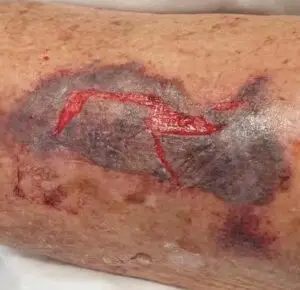Page Contents
Skin tear is a wound caused by the skin being pulled, stretched, or sheared. Imagine peeling an orange, where the thin layer of skin is separated from the fruit underneath — this is similar to what happens with a skin tear. This injury occurs frequently among older adults due to their fragile skin. As we age, the skin becomes thinner, less elastic, and more prone to damage. In elderly individuals, especially those in nursing homes, skin tears are a common and significant problem that can lead to discomfort, infection, and more severe complications if not managed properly.

Statistics and trends
Skin tears are surprisingly frequent among the elderly. Studies indicate that the prevalence of skin tears in long-term care facilities ranges from 14% to 24%, with nursing home residents being particularly vulnerable. A study in the U.S. showed that over 1.5 million skin tears occur annually in institutionalised elderly individuals. Moreover, women, individuals over 75 years old, and those who require assistance with mobility are at higher risk of developing skin tears. This statistic underlines the importance of awareness and proactive management in nursing homes and eldercare settings.
Causes of skin tears
Skin tears happen when external forces such as friction, blunt trauma, or even something as simple as pulling on clothing or sheets cause the delicate skin of an older adult to tear. The reduced collagen and weakened elasticity of the skin, combined with thinning subcutaneous fat, make elderly skin more vulnerable to injuries.

Additionally, medical conditions like diabetes, malnutrition, or dehydration further increase susceptibility. Many elderly people experience mobility issues, which can lead to accidental bumps or falls — another leading cause of skin tears. Routine activities like transferring residents from bed to chair can inadvertently result in these injuries if not done carefully.
Different types of skin tears
Skin tears are generally classified into three categories:
- Type 1: No skin loss
The epidermal layer is separated from the dermis but remains intact. This is the least severe and easiest to treat. - Type 2: Partial skin loss
There is some degree of skin loss, and part of the epidermis is missing, exposing the underlying tissue. - Type 3: Total skin loss
This is the most severe type, where the epidermis and dermis are completely separated, leaving an open wound that requires immediate medical attention.

Complications of skin tears
When skin tears are not managed properly, several complications can arise. One major concern is infection. Since the elderly often have weakened immune systems, skin tears can quickly become infected if bacteria enter the open wound. This can lead to cellulitis (skin infection), sepsis, or even tissue necrosis in severe cases.

Additionally, poorly treated skin tears can result in prolonged healing times, increased discomfort, and scarring. In some cases, the wound can deteriorate into a chronic wound, further complicating care.
How are skin tears treated?
Treating skin tears in elderly individuals should be done carefully and promptly. The first step is to cleanse the wound with a saline solution to reduce the risk of infection. If the skin flap is viable (for Type 1 or Type 2 tears), it should be gently realigned over the wound and covered with a non-adhesive dressing. In more severe cases, where skin loss is significant, hydrocolloid or foam dressings may be used to promote a moist healing environment. Regular dressing changes and monitoring for signs of infection are critical to effective wound healing. For larger, deeper tears, a healthcare professional might need to apply sutures or even surgical intervention.
Preventing skin tears in the elderly
Preventing skin tears requires a multi-faceted approach involving both caregivers and environmental considerations. Here are key prevention strategies:
Hydration and skin moisturization
Keeping the skin well-hydrated is essential. Elderly skin can easily become dry and brittle, making it more prone to tears. Regularly applying moisturizing creams can improve skin elasticity and reduce the likelihood of injuries.Balanced nutrition
A diet rich in protein, vitamins (particularly vitamins A and C), and minerals like zinc plays a crucial role in maintaining skin health and promoting wound healing. Elderly individuals who suffer from malnutrition are more vulnerable to skin breakdown and tears.Proper clothing
Encourage the use of long sleeves and soft, loose-fitting clothes to minimise skin friction and reduce the risk of accidental tears. When handling elderly individuals, caregivers should avoid using tapes or bandages directly on fragile skin.Caregiver’s role
Caregivers play an important role in preventing skin tears. Training caregivers on safe transferring techniques and proper handling of elderly residents is essential. Being gentle while helping with movements, avoiding abrupt motions, and using assistive devices like transfer boards or mechanical lifts when needed can all reduce the chance of skin injuries.Environmental safety
Modifying the living environment can also reduce the risk of skin tears. Installing padded furniture edges, removing sharp objects, and ensuring adequate lighting can prevent accidental injuries from falls or bumps.
Conclusion
Caring for elderly individuals, especially in nursing home settings, requires attention to even the smallest of injuries, like skin tears. These seemingly minor wounds can lead to significant complications if not properly managed. By prioritising prevention through proper skincare, nutrition, safe handling practices, and environmental safety, caregivers can greatly reduce the risk of skin tears. Ultimately, a proactive approach ensures the comfort, dignity, and well-being of elderly residents, fostering a safer and healthier living environment.
